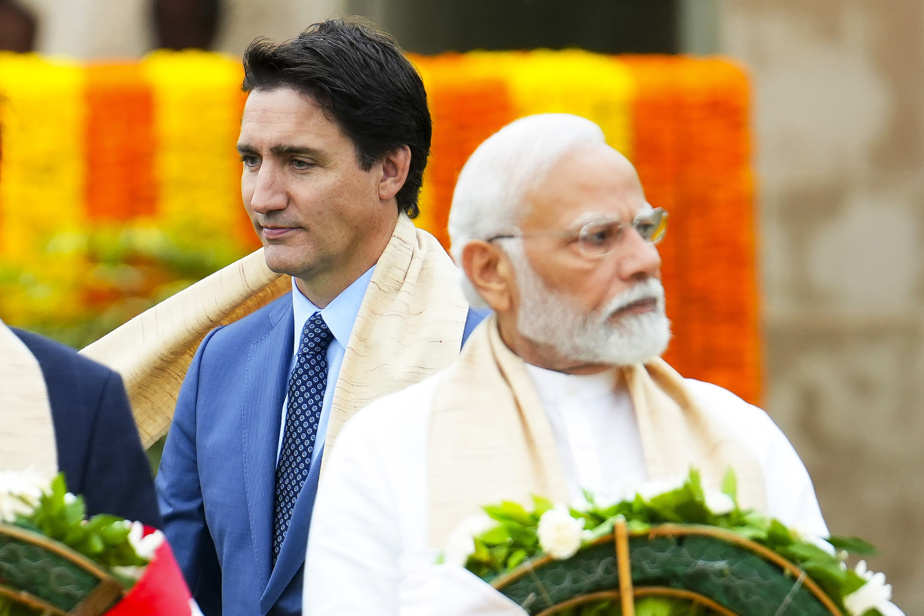(Ottawa) The repatriation of around forty of the 61 Canadian diplomats stationed in India around ten days ago could prevent Canada from reaching its immigration targets, a direct consequence of the very tense relations between Ottawa and New Delhi.
This is because for several years, India has been Canada’s main source of immigrants. In 2022, the country welcomed a record number of 437,120 permanent residents. And of this number, 118,085 immigrants came from India, or 27% of the total.
China came in second place, but far behind, with 31,815 permanent residents from this country (or 7.2% of the total), another country with which relations are far from good.
In 2021, immigrants from India represented 32% (127,933 immigrants) of the total permanent residents who were accepted into the country.

PHOTO DON MACKINNON, AGENCE FRANCE-PRESSE ARCHIVES
The Guru Nanak Sikh Gurdwara temple in Surrey, British Columbia, where Hardeep Singh Nijjar was murdered last June
Relations between the two countries have been at an all-time low since Prime Minister Justin Trudeau put India in the dock. In a statement to the House of Commons on September 18, he said Canada had “credible allegations” that agents linked to the Indian government played a role in the assassination of a Canadian of Sikh origin, Hardeep Singh Nijjar, in June in Surrey, British Columbia. New Delhi denied the accusations, saying they were “absurd”.
Hardeep Singh Nijjar was accused of murder conspiracy and terrorism in India. He was reportedly the subject of death threats because of his support for an independent Sikh state in Khalistan, India.
“Our workforce has been reduced”
Last year, Canada set a goal of welcoming 465,000 new permanent residents this year, 485,000 in 2024 and 500,000 in 2025. Minister of Immigration, Refugees and Citizenship, Marc Miller , must submit to Parliament, no later than 1er November, the multi-year plan for immigration levels from 2024-2026.

PHOTO SEAN KILPATRICK, CANADIAN PRESS ARCHIVES
The Minister of Immigration, Refugees and Citizenship, Marc Miller
Minister Miller indicated to The Press that he expects that tensions between India and Canada, if not eased, will affect the ability to assess the processing of immigration applications from that country.
Last week, Canada was forced to significantly reduce its diplomatic presence in India, a clear sign that tensions between Ottawa and New Delhi are far from easing. Several of the Canadian employees processed immigration applications.
The main sources of immigrants for Canada in 2022
- India (118,095 immigrants) – 27%
- China (31,815 immigrants) – 7.2%
- Afghanistan (23,735 immigrants) – 5.4%
- Nigeria (22,085 immigrants) – 5.05%
- Philippines (22,070 immigrants) – 5.04%
- France (14,145 immigrants) – 3.2%
- Pakistan (11,585 immigrants) – 2.6%
- Iran (11,105 immigrants) – 2.5%
- United States (10,400 immigrants) – 2.3%
- Syria (8500 immigrants) – 1.9%
“It is certain that our capacity to process requests will be affected. Approximately 38,000 immigration applications were expected to be processed [de l’Inde] by December. We will only be able to process 20,000, or almost half. Our numbers have been reduced,” confirmed Minister Miller, also stressing that India is an important source of immigrants.
“It’s an evolving situation. There is a very important diplomatic dispute between Canada and India at the moment. We will do our best to process requests wherever possible. Obviously, in recent years, we have been able to increase our capacity to do things abroad, outside of India. But there are things you have to do in person. »
The worst thing that could happen would be to affect the lives of people who want to come to Canada or who have the right to stay here.
Marc Miller, Minister of Immigration, Refugees and Citizenship
Regarding immigration targets, Mr. Miller said the government has not yet made a decision on whether or not it should review its targets. “The targets have been announced [pour 2024 et 2025]. Is there a need to rework them just a little bit? This is a question that has not yet been decided,” he said.
41 diplomats brought home
In total, the Trudeau government had to bring back 41 of the 62 Canadian diplomats who were serving in India because they risked having their diplomatic immunity revoked – which could have endangered their safety and that of their families.
The Indian government demanded that Ottawa reduce the size of Canadian representation in India so that it was comparable to that maintained by New Delhi in Canada.
To everyone’s surprise, the Indian High Commission in Canada announced last week that officials would resume processing certain types of visa applications in Ottawa and at the consulates in Toronto and Vancouver (business visas, visas medical and conference visas, as well as applications from people who have family ties in India).
New Delhi suspended these services a month ago in Indian offices in Canada and for Canadian citizens elsewhere in the world.
with the collaboration of William Leclerc, The Press
